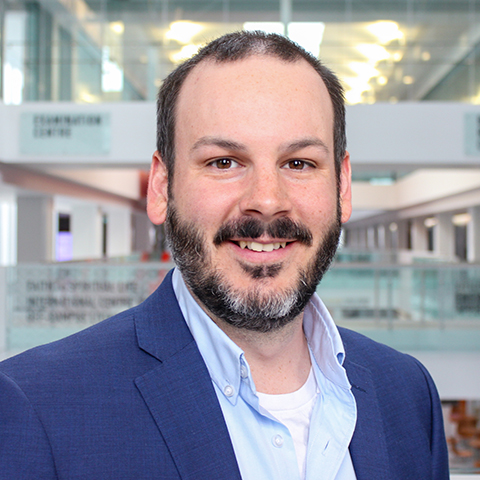
My research projects help to address the following UN Sustainable Development Goals:
Professor Woods joined as an Assistant Professor and researcher in the Department of Civil Engineering at Queen’s University in January 2020.
Professor Woods graduated with a Bachelor of Engineering in 2008 from Carleton University. After graduation he spent a short time working in industry and returned to Carleton to pursue a Master’s degree under the supervision of Dr. David Lau, which focused on the application of externally bonded CFRP sheets to improve the seismic performance of deficient reinforced concrete shear wall buildings.
After completing his Master’s degree, Professor Woods stayed at Carleton University to complete his PhD, where he contributed to the establishment of the CFI funded Multi-Hazard Research and Testing Facility with his Doctoral supervisors Dr. David Lau and Dr. Jeffrey Erochko. During his PhD work, Professor Woods had the opportunity to take part in a research exchange at the National Centre for Research on Earthquake Engineering (NCREE) in Taiwan. Professor Woods’ doctoral work focused on the application of hybrid simulation, an innovative experimental test method, to study the realistic seismic response of reinforced concrete shear wall buildings. For his contributions as a PhD student at Carleton University, Professor Woods was awarded the University Medal.
Upon completion of his PhD degree, Professor Woods spent one year as a postdoctoral fellow at Polytechnique Montreal working on advanced applications of hybrid simulation in earthquake engineering under the supervision of Dr. Robert Tremblay and Dr. Najib Bouaanani.
Education
Professional & Academic Experience
Professional Memberships
Professor Woods’ research can be broadly categorized into three primary areas of specialization: (1) the use of high-performance materials and structural systems for seismic resilience, (2) large-scale experimental testing and the development of advance test methods (e.g. hybrid simulation) for full-scale civil structures, and (3) the application of advanced sensors for structural monitoring and condition assessment of structures. The goals of this research are to ensure that we have safe, resilient, and smart infrastructure today and for the future.
High-Performance Materials and Structural Systems
Research in this area includes the use of high-performance materials and structural systems to improve the seismic performance and resilience of new and existing structures. For existing structures, this includes the use of externally bonded carbon fibre-reinforced polymer (CFRP) sheets to retrofit existing deficient or damaged reinforced concrete structures. In new construction, combined heavy-timber steel structural systems are a sustainable alternative to conventional steel and concrete structures and have the potential to reduce the global effects of climate change.
Advanced Large-scale Experimental Testing
Dr. Woods works closely in collaboration with colleagues at Queen’s University and other institutions in Canada (e.g. Carleton University in Ottawa and Polytechnique Montreal) to better understand the system-level performance of large-scale civil structures using an advanced experimental test method known as hybrid simulation. Large-scale experiments are conducted using the structures laboratory at Main Campus as well as the unique Buried Infrastructure laboratory at West Campus.
Structural Health Monitoring and Condition Assessment
In all of his research projects, Dr. Woods employs advanced sensors to better understand the behaviour of structural components or systems, including the use of distributed fibre optic sensors to measure strain distributions and the use of digital image correlation to measure two-dimensional strain and displacement fields over the surface of a structural component. These advanced technologies have great potential to be applied to monitoring the long-term performance of civil engineering structures as well as assess their condition following an extreme event.
Nicoletta, B., Woods, J., Gales, J. and Fam, A. (2019). Postfire Performance of GFRP Stay-in-Place Formwork for Concrete Bridge Decks. Journal of Composites for Construction, 23(3). (Link)
Gohlich, R., Erochko, J. and Woods, J. (2017). Experimental Testing and Numerical Modelling of a Heavy Timber Moment-Resisting Frame with Ductile Steel Links. Journal of Earthquake Engineering and Structural Dynamics, 47(6): 1460-1477. (Link)
Lau, D. and Woods, J. (2017). Concentric Tube Anchor System for FRP Retrofit of RC Structural Walls under Extreme Loads. International Journal of Protective Structures, 9(1). (Link)
Woods, J., Lau, D., Bao, X., and Li, W. (2017). Measuring Strain Fields in FRP Strengthened RC Shear Walls using a Distributed Fiber Optic Sensors. Engineering Structures, 152: 359-369. (Link)
Woods, J., Lau, D. and Cruz-Noguez, C. (2016). In-plane Seismic Strengthening of Nonductile Reinforced Concrete Shear Walls using Externally Bonded CFRP Sheets. Journal of Composites for Construction, 20(6). (Link)
Honours & Awards
Please feel free to contact Dr. Woods (joshua.woods@queensu.ca) about potential projects if you are interested in pursuing graduate studies at Queen’s University!